Steel production is the backbone of modern infrastructure, but the industry is under constant pressure to increase output while managing costs and environmental impact.
For plant managers and engineers, maximizing manufacturing efficiency is not just a goal; it’s a necessity for survival in a competitive global market.
Achieving this requires a comprehensive approach, from optimizing raw material handling to upgrading critical machinery components. This post will explore practical strategies for enhancing efficiency in steel production.
We will cover key areas where improvements can yield significant returns, including process optimization, energy management, and the adoption of advanced technologies.
By implementing these methods, your facility can reduce downtime, lower operational costs, and boost overall productivity in your industrial processes.
1. Streamline Raw Material Handling and Preparation
The journey to efficient steel production begins long before the furnace is lit. The way raw materials like iron ore, coke, and limestone are handled and prepared directly impacts the entire manufacturing chain.
Inefficiencies at this stage can lead to production delays and increased energy consumption.
Optimizing Logistics
- Automated Conveyor Systems: Implement automated systems to transport materials from storage to the furnace. This minimizes manual labor, reduces spillage, and ensures a consistent flow of inputs.
- Inventory Management: Use advanced inventory management software to track raw material levels accurately. This prevents shortages that could halt production and avoids overstocking, which ties up capital.
Improving Material Quality
- Consistent Sizing: Ensure raw materials are crushed and screened to a uniform size. Consistent particle size allows for more predictable and efficient reactions in the blast furnace.
- Moisture Control: Implement measures to control the moisture content of raw materials. Excess moisture requires more energy to evaporate, increasing fuel consumption and processing time.
2. Enhance Blast Furnace and Smelting Operations
The blast furnace is the heart of steel production, and its performance is critical to overall efficiency. Optimizing the smelting process can lead to substantial energy savings and higher yields of molten iron.
Advanced Process Control
- Sensor Technology: Install modern sensors to monitor key parameters like temperature, pressure, and gas composition in real-time. This data allows operators to make immediate adjustments to maintain optimal conditions.
- Predictive Analytics: Utilize AI and machine learning models to analyze process data and predict potential issues before they occur. This proactive approach helps prevent costly downtime and maintains stable operation.
Fuel and Energy Efficiency
- Pulverized Coal Injection (PCI): Adopt PCI technology to supplement or replace more expensive coke. This can lower fuel costs and reduce the carbon footprint of the operation.
- Top Gas Recovery: Install a top gas recovery turbine to capture the high-pressure gas exiting the furnace. This recovered energy can be used to generate electricity, reducing the plant’s reliance on the external grid.
3. Implement Continuous Casting and Rolling
Traditional ingot casting is a batch process that involves multiple cooling and reheating steps, consuming significant time and energy.
Continuous casting is a more modern and efficient alternative that has become standard in high-volume steel production.
Benefits of Continuous Casting
- Reduced Energy Consumption: By casting molten steel directly into semi-finished shapes like billets or slabs, the need for reheating is minimized, saving a tremendous amount of energy.
- Higher Yield: This method reduces material loss from cropping and scaling, resulting in a higher yield of usable steel from the same amount of molten metal.
- Improved Quality: The rapid and controlled solidification process of continuous casting leads to a more uniform internal structure and better surface quality in the final product.
Integrating with Rolling Mills
Linking the continuous caster directly to the rolling mill creates a seamless, uninterrupted production line.
This hot-charging process eliminates the need to cool and then reheat slabs before rolling, further boosting manufacturing efficiency and throughput.
4. Upgrade Machinery with High-Performance Components
The reliability of machinery is paramount in a 24/7 operation like a steel mill. Unexpected equipment failure can bring production to a grinding halt, leading to massive financial losses.
Investing in durable, high-performance components is a smart strategy to enhance reliability.
The Role of Couplings in Steel Mills
Mechanical power transmission is a critical part of steel production, from conveyors to rolling mills. The couplings that connect rotating shafts play a vital role in protecting equipment from shock loads, misalignment, and vibration.
- Elastomeric Flexible Coupling: An elastomeric flexible coupling is particularly well-suited for the harsh conditions of a steel mill. Its flexible element can absorb shock and dampen vibrations, protecting expensive equipment like motors and gearboxes from premature failure.
- Benefits: Using a high-quality elastomeric flexible coupling extends the service life of connected machinery, reduces maintenance needs, and minimizes the risk of catastrophic failure, all of which contribute to improved operational uptime.
5. Adopt Robust Maintenance Strategies
A reactive “fix-it-when-it-breaks” approach to maintenance is a recipe for inefficiency. A proactive and strategic maintenance plan is essential for keeping industrial processes running smoothly.
Predictive Maintenance
- Condition Monitoring: Use techniques like vibration analysis, thermal imaging, and oil analysis to monitor the health of critical equipment in real-time.
- Data-Driven Decisions: This data allows maintenance teams to predict when a component is likely to fail and schedule repairs during planned downtime, avoiding costly emergency shutdowns.
Preventive Maintenance
- Scheduled Servicing: Develop a comprehensive schedule for routine maintenance tasks such as lubrication, cleaning, and inspections.
- Component Replacement: Proactively replace wear parts, like seals and bearings, before they reach the end of their expected service life to prevent unexpected breakdowns.
6. Focus on Energy Management and Recovery
Steel production is one of the most energy-intensive industries. A dedicated focus on energy management can unlock significant cost savings and improve the environmental performance of the plant.
Waste Heat Recovery
- Furnace and Caster Heat: Install heat exchangers to capture waste heat from furnaces, casters, and hot-rolled steel. This recovered thermal energy can be used for preheating air, generating steam for power, or providing facility heating.
- Cogeneration: Implement combined heat and power (CHP) systems that produce both electricity and useful heat from a single fuel source, maximizing energy utilization.
Efficient Energy Use
- Variable Frequency Drives (VFDs): Install VFDs on large motors, such as those used for fans and pumps. VFDs allow the motor speed to be adjusted to match the load, significantly reducing electricity consumption compared to running motors at full speed all the time.
- Energy Audits: Conduct regular energy audits to identify areas of waste and opportunities for improvement across the entire facility.
Elevating Your Production Capabilities
Boosting efficiency in steel production is a multi-faceted endeavor that demands attention to every stage of the manufacturing process.
From optimizing raw material flow to embracing predictive maintenance and recovering waste heat, each improvement contributes to a more productive, cost-effective, and sustainable operation.
Investing in advanced technologies and high-quality components, such as a robust elastomeric flexible coupling, is crucial for ensuring the reliability and longevity of your machinery.
By taking a strategic and holistic approach, steel producers can build a more resilient and competitive enterprise for the future.



Leave a Comment